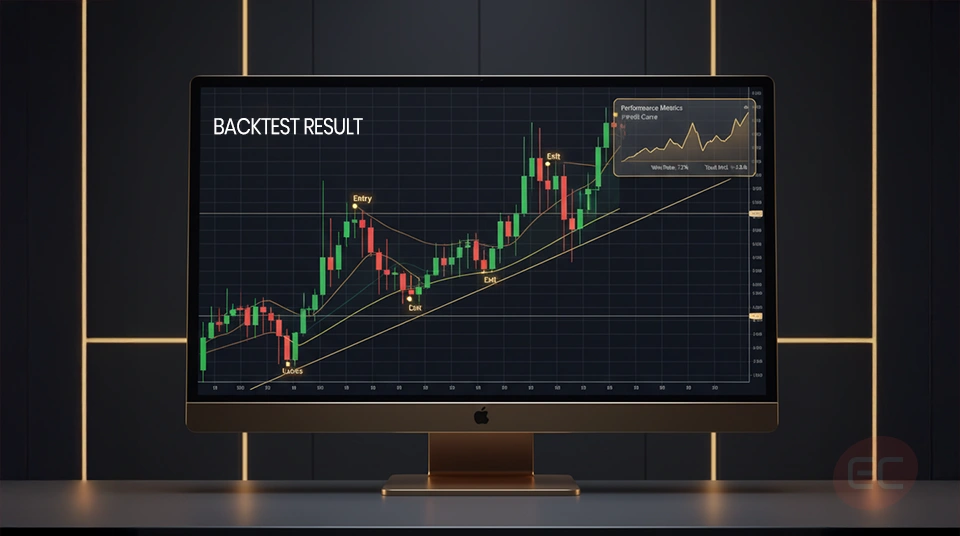Creating a Trading Strategy
Do you sometimes feel like you're just making a guess when you trade? Clicking buy because it "seems like the right choice” and just kind of hoping it goes your way? Well believe it or not, this is more common than you think. But real successful traders know one rule, and they live by it: you don’t win by guessing, you win with a plan, a strategy, something that you believe in and stay true to. And that’s exactly why creating proper day trading strategies is non-negotiable.
In this article, we are going to walk through step by step how to learn to build a personalised trading strategy from scratch, including:
- The difference between day trading strategies and options trading strategies.
- How to backtest a trading strategy to make sure your strategy is optimised.
- How to customise your plan to your goals and risk tolerance.
- How to actually stick to it when emotions kick in.
Let’s start from the very top and build your strategy, step by step, starting with what is a trading strategy.
What are Day Trading Strategies?

Before we dive into the specifics, let’s break down the basics. A trading strategy is simply a set of rules that indicate:
- When to enter a trade
- When to exit (either with profit or a loss)
- How much to risk
- What market conditions to look for
The main goal is consistency, a good strategy takes the guesswork out and helps you stay objective, no matter the circumstances, even when things get emotional. So whether you're building a day trading strategy or you’re planning options trading strategies, the structure is the same. In essence, the tools and timeframes might vary, but the foundation remains constant.
How to create Day Trading Strategies
Let’s start talking about day trading strategies. Day trading is about entering and exiting trades within the same day, most often in a matter of minutes or hours. It’s a bold choice as it requires fast decision-making, extreme discipline, and a solid game plan, one that you must trial and test and once you have a game plan you’re confident with, stick to it.
So, what goes into strong day trading strategies? Let’s break down some steps that will help you plan your day trading strategies.
1. Define your Entry Rules
You can’t just buy because the price looks low, you need clear signals, so you can actually back up your decisions. Here are some examples of clear signals to follow:
- Breakout of support/resistance
- Candlestick patterns (engulfing, pin bar)
- Moving average crossovers
2. Plan out a tight Risk Management Strategy
Day trading moves quickly, that’s why stop-losses and position sizing are absolutely essential in all effective day trading strategies, so plan out your risk management effectively and stick to it.
3. Set specific Profit Targets
At what point will you take profits? Use risk-reward ratios (take 1:2 as the most common example) to set targets before you actually enter.
4. Timeframe & Tools
Most day trading strategies use the 1-minute, 5-minute, or 15-minute chart. Some of these tools include:
- VWAP (volume-weighted average price)
- RSI
- Price action
So what's the key to successful day trading strategies? If we could narrow it down, we would say: repeatable setups and emotional control. If you can manage them effectively, you might want to consider day trading as your trading style.
Options Trading Strategies
Now, let’s shift to options trading strategies. Options give you the ‘option to’, but not the obligation, to buy or sell an asset at a specific price before a specific date. This adds flexibility, but of course, like anything it also adds complexity. Let’s break it down.
How to build reliable Options Trading Strategies?
1. Choose a bias: Bullish, Bearish, or Neutral
Each strategy aligns with your market outlook, here’s how to choose:
- Bullish? Maybe consider long calls or bull call spreads
- Bearish? Use long puts or bear put spreads
- Neutral? Try iron condors, straddles, or strangles
2. Define Risk/Reward
The best part about options trading strategies is the ability to define risk upfront, you should always know:
- Max loss
- Max gain
- Break-even points
3. Select Strike Price & Expiry
Your strike price should match your conviction, and the expiry should give the trade enough time to play out, unless of course you’re scalping short-term moves.
4. Volatility Awareness
Implied volatility affects option pricing, and many options trading strategies rely on volatility rising (buyers) or falling (sellers). So in this case, timing is crucial.
How to Backtest Day Trading Strategies and Why it’s so important
You’ve got a strategy idea? That’s great! But here’s a question:
How do you know it works? Have you tested it for yourself? If the answer is no, then that’s where knowing how to backtest a trading strategy comes in.
So let's learn how to backtest a trading strategy correctly. This is one of the most important factors in your trading plan, so here’s a step by step guide to help you get started
Step-by-step Backtesting Process:
1. Define your clear rules
When defining your rules, be specific, ask yourself what triggers your entry, and what confirms your exit?
2. Choose a market and timeframe
Are you backtesting your day trading strategies on the 5-minute chart? Or testing options trading strategies on daily candles? Choose a market and timeframe that works for you, test it, and apply it.
3. Scroll back in time
Use historical charts, go candle by candle and simulate the trades using your rules.
4. Track the results
Note everything down, including:
- Entry price
- Exit price
- Stop-loss
- Profit/Loss
- Risk-to-reward
- Win rate
5. Analyse the data
Look for specific patterns, are you profitable over time? Are certain setups more successful than others?

By learning how to backtest a trading strategy, you can remove the guesswork and build up your confidence.
So let’s start building your trading strategy!
Building your own Day Trading Strategies
Here’s how to start building your trading strategy, let’s break it down step by step.
1. Market & Timeframe
Choose your focus, which market do you want to focus on:
- Stocks, crypto, Forex?
- Day trade or swing trade?
2. Tools/Indicators
Decide what you’ll use:
- Price action
- RSI, MACD, moving averages
- Volume
3. Entry Rules
For example: "Enter when the price breaks the resistance with 2x the average volume."
4. Stop-Loss & Risk
Number one rule to stick to: do not risk more than 1–2% of your account per trade.
5. Exit Strategy
For example: "take profit at 2x risk, or when the RSI hits overbought."
So whether you’re testing day trading strategies, building options trading strategies, or just learning how to backtest a trading strategy, this structure is crucial to the success of your trading experience.
Adapting your Day Trading Strategies as you Grow
Here’s a secret most traders won’t tell you: your first strategy probably won’t be your last. Why? Well, simple really, because like anything in life, as you gain experience, you’ll naturally refine your approach.
So maybe you’ll start with basic day trading strategies using moving averages, and then you’ll learn how to backtest a trading strategy and realise certain setups work better for you, eventually, you explore options trading strategies to hedge or scale profits.
It’s all part of the process. Your strategy should grow with you, that’s progress. Limiting yourself to the strategy you first started off with can only get you so far, so as you learn, your strategy should be growing with you.
Conclusion: Creating Day Trading Strategies
If you’ve made it this far into the course, you should now know:
- What makes strong day trading strategies.
- How to design flexible options trading strategies.
- Why learning how to backtest a trading strategy is crucial for long-term success.
It’s easy to chase trades or copy others, but creating your own trading strategy puts you in control, and it can make the difference between a profitable trade, and a loss.
And in trading, control = power. So take the time to test it, tweak it, and improve it. Understanding how to backtest a trading strategy is the foundation of confidence. When you know your strategy performs under various conditions, you no longer rely on luck - you rely on proof. Start small, stay consistent and let your strategy do most of the heavy lifting, so you don’t have to guess ever again.
If you stick to these rules and you test over and over again using a demo account, you will build a strong foundation for your trading strategy and be a step closer to switching to a live trading account.
We hope you enjoyed this course on ‘creating a trading strategy’. If you’re looking to gain more knowledge in the global financial markets, then keep reading the EC Markets Academy as we unlock more topics that will get you from a beginner trader to a knowledgeable and confident trader!